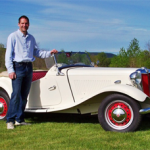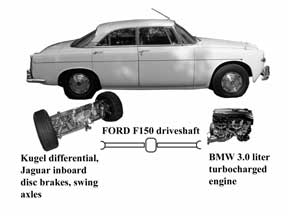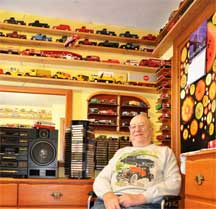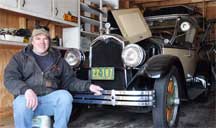Waterless Coolant?
I have been seeing reference to a waterless coolant lately. I read a column written by Jay Leno in which he touts the advantages to waterless coolant. After doing a little research, I have come to the conclusion that the invention of waterless coolant is another advantage we in the old car hobby can take advantage of, much like modern engine oil and silicone brake fluid.
Ok, what is waterless coolant? Conventional coolant is a 50/50 mixture of ethylene glycol and water with either supplemental coolant ad-ditives (SACs) or long-life organic acid technology (OAT) additives. To keep the coolant operating properly and to protect engine parts, the additives must be checked and maintained periodically. The coolant breaks down over time, and must be flushed and replaced. Failure to maintain conventional coolant will result in both failure to cool the engine, as well as corrosion to engine and cooling system components. Ethylene glycol is also highly toxic. Three tablespoons is a lethal dose. Every year thousands of animals die after consuming conventional coolant, being attracted to the sweet smell.
Glycol-based waterless coolant has recently gained popularity as a maintenance-free alternative to traditional coolants. Brought to market about a decade ago, the waterless coolant provides adequate lubrication for water pumps. Because no water is in the coolant, there’s no need to use additives to protect engines from water’s deleterious effects.
Traditional vs. waterless coolant…
Water is an excellent heat-transfer medium when liquid, but it changes state. When it boils at 212° F, it creates vapor pockets that can insu-late and hold heat in the metal rather than transferring heat away. When below 32° F, water freezes, expanding to generate enough pressure to crack engine blocks.
Freezing/boiling levels…
Traditional, fully formulated coolants prevent freezing to -34° F. It also raises the boiling point to 224°. Since engines operate at close to water’s boiling point, the glycol adds a safety margin to prevent boil-over. Additional margin is provided by pressurizing the closed cooling system to 1 atmosphere (15 psi) above ambient. With the pressure cap, water boils at 250° and 50/50 coolant boils at 263°.
Waterless coolant, however, won’t freeze below 40° F and boils at above 375° — even without pressurization — giving a huge safety mar-gin. Water carries scale-forming minerals, so waterless coolant prevents scale buildup. It doesn’t need a 15-psi radiator cap — the manufacturer recommends 1 to 2 psi, just enough to close the system. With no water to boil off, localized hot spots and mineral deposits are avoided.
Engine protection…
Pitting is caused when water vapor bubbles form next to cylinder liners as they flex from the side thrust of pistons. When the bubbles im-plode, coolant impacts the outer walls of the liners with enough force to drill through. That lets coolant into cylinders and the oil sump.
In traditional coolants, supplemental additives form a protective coating that absorbs most of the impinging force. Without the protection, repeated implosions drill holes in the steel liners. Also, organic acids in long-life coolants protect from pitting. Protection levels must be moni-tored.
With waterless coolant, no water vaporizes and no bubbles form as the liners flex. Waterless coolant prevents voids. Since water is a corro-sive agent, waterless coolant also resists corrosion.
Damage caused by corrosion from coolant can be very expensive to fix, or could even ruin an engine.
Safety…
The antifreeze in Evans’ coolant is mostly propylene glycol, not ethylene glycol found in conventional coolants. Unlike ethylene glycol, propylene glycol is nontoxic. In fact, pure propylene glycol is used as a sweetener in many medications. If propylene glycol leaks and is in-gested, no harm is done.
The drawbacks of waterless…
Availability. You may be able to limp home on a slow leak, but if something catastrophic like a burst radiator happens, you can’t just repair it and replace with ordinary coolant. You need to find a service provider that carries Evans’ coolant. If you just add water, you lose all the bene-fits of your expensive changeover.
Expense…
Evans coolant is not cheap, it costs upwards of $40/gallon, roughly twice the price of $15 – $20/gallon for traditional coolant. I have seen it available on line for less.
For a collector car that will be maintained indefinitely, waterless coolant makes sense. It is expensive, but will pay for itself over the long haul. Skipping the chore of flushing and replacing the coolant every few years (everybody reading this does this, right?) and avoiding the costly effects of corrosion in the engine make this product save money overall. There is also the added benefit of it being non toxic, potential-ly saving a life should the coolant escape the cooling system.
An engine rebuild can easily reach costs of $4,000 or more. Waterless coolant is a cost effective means to protect your investment.
More information can be found at the Evans website: http://www.evanscooling.com/
 Please email all inquiries to: Dave
Please email all inquiries to: Dave
or snail mail
32 Turkey Hill Road
Richmond VT 05477










 I have always liked the styling of the classic Saab 900, especially the 3-door hatchback. With a unique, aircraft inspired shape and a nod to safety, comfort and practicality, there was never another car with the look of a C900.
I have always liked the styling of the classic Saab 900, especially the 3-door hatchback. With a unique, aircraft inspired shape and a nod to safety, comfort and practicality, there was never another car with the look of a C900. Please email all inquiries to:
Please email all inquiries to: 
 If you remember, Wheel Tracks had a really nice story about a fire truck from St. Albans, VT that was turned into a ‘Speedster’ back in the February issue. A question was simply asked at the end about the car in the picture that was “the fire chief’s car. “What make and year is the car?”
If you remember, Wheel Tracks had a really nice story about a fire truck from St. Albans, VT that was turned into a ‘Speedster’ back in the February issue. A question was simply asked at the end about the car in the picture that was “the fire chief’s car. “What make and year is the car?” The Buick is owned today by Sue and Greg Sabens and the “garage” was just up the road from Alden’s home. Greg’s Dad, Dell, had purchased it from Charlie Arnholm on August 12th 1965, Charlie was a longtime VAE member and club president in 1961. A meeting was set up and Jim Sears and I went South to find this garage. You can see the garage on the front page with the Buick looking out from the shadows. As it turned out, the gar-age is at the home of Dell’s wife, Helen, who was the person who did all the leather and fabric work for the Buick restoration. The family lost Dell some fifteen years ago, but it was easy for us to know a little about him from seeing his part of the loving restoration on this car. Charlie Arnholm was known for his great abilities with the pin-striping brush and the Buick carries some of his work. Charlie Arnholm was also the second
The Buick is owned today by Sue and Greg Sabens and the “garage” was just up the road from Alden’s home. Greg’s Dad, Dell, had purchased it from Charlie Arnholm on August 12th 1965, Charlie was a longtime VAE member and club president in 1961. A meeting was set up and Jim Sears and I went South to find this garage. You can see the garage on the front page with the Buick looking out from the shadows. As it turned out, the gar-age is at the home of Dell’s wife, Helen, who was the person who did all the leather and fabric work for the Buick restoration. The family lost Dell some fifteen years ago, but it was easy for us to know a little about him from seeing his part of the loving restoration on this car. Charlie Arnholm was known for his great abilities with the pin-striping brush and the Buick carries some of his work. Charlie Arnholm was also the second